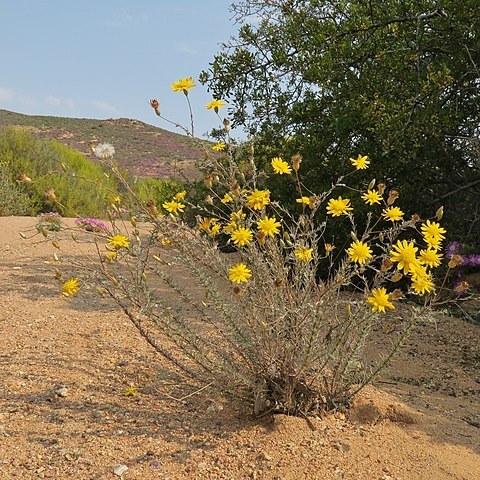A tomentose-glabrescent and glandular shrublet, c. 0.2-0.5 m high. Leaves laxly-densely set, sometimes crowded on short, lateral branchlets (brachyblasts), linear, 2-25 mm long, 0.5-1 or occasionally 1.5 mm wide, greyish-tomentose to green and glabrescent, ventrally furrowed and somewhat tomentose, glandular. Peduncles smooth or seldom laxly tomentose, 15-70 mm long or occasionally only 5-15 mm long. Involucre cyathiform-campanulate, 4-20 but usually >8 mm wide. Involucral bracts 20-110, smooth or occasionally laxly tomentose dorsally, acute-obtuse-rounded; outer small and ovate; inner gradually longer and oblong-somewhat spatulate with a scarious and often marginally brown apical limb, 6-11 x 0.8-2.4 mm. Receptacle flat-convex, scabrid with small projections or occasionally shortly squamose, furnished with a distal row of acute or apically laciniate, 1-5.5 mm long, persistent scales. Ray-florets 8-45. Tube cylindrical, glabrous or with scattered, subulate-conical, multicellular hairs. Lamina elliptic-oblong, 4-12 x 1-3 mm. Achenes 2.8-5 mm long, with laxly-densely scattered, slender, tricellular hairs (twin hairs) and often with a basal tuft of similar hairs, remaining clasped between the spreading, receptacular scales and the innermost involucral bracts. Pappus of short, flat, acute-obtuse, white scales but with no bristles. Disc florets 35-450, perfect. Corolla 3.8-6.5 mm long; tube with scattered, subulate-conical, multicellular hairs and often with a collar of similar, densely set hairs just below the limb. Anthers 1.8-3.5 mm long, with a truncate apical appendage. Achenes 2.8-5 mm long, glabrous or with few, scattered, slender, tricellular hairs (twin hairs) and often with a basal tuft of similar hairs. Pappus of short, flat, acute-obtuse, white scales and 5 or occasionally 3-4 outer, evenly plumose (except for the extreme base), white bristles.
More
Perennial shrublet, ± 0.2-0.5 m high. Leaves linear, glandular. Peduncles (5-) 15-70 mm long; involucre (4-)8-20 mm wide; involucral bracts 20-110, smooth or occasionally laxly tomentose dorsally, inner gradually oblong to somewhat spathulate with a scarious and often marginally brown apical limb, 6-11 x 0.8-2.4 mm. Ray florets 8-45, lamina elliptic-oblong, lamina 4-12 x 1-3 mm. Disc florets 35-450, perfect, corolla 3.8-6.5 mm long; tube hairy with a collar of hairs just below the limb. Flowering time Sept.-Nov. Pappus of short, flat scales and in disc florets (3-)5 outer bristles. Cypselae 2.8-5.0 mm long, with twin hairs.
Glabrescent or cobwebby shrublet with erect stems, up to 400 mm tall. Leaves linear, 2-25 mm long, glabrescent to cobwebby, especially beneath, and glandular-hairy, with margins rolled under. Flowerheads solitary on slender, wiry peduncles, radiate, yellow, 10-15 mm diam.; involucral bracts with papery, often brownish tips. Pappus bristles plumose from base.
A herb or small shrub. It grows 50 cm high. The leaves are simple and alternate. They are narrow and grey green. They are 20-25 mm long by 1 mm wide. The flowers are daisy like and occur as single heads. They are on a long slender stalk. The flowers are yellow.
Glabrous to cobwebby shrublet to 40 cm. Leaves linear, glandular-hairy. Flower heads radiate, solitary on slender, wiry peduncles, yellow; pappus bristles plumose from base.

